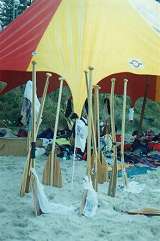|
Open beaches
Barbara Jensen
We Australians love the ocean, it's our place to relax, walk, play, fish and holiday. It's the beach that is our focus and our starting point for exploring the ocean environments.
The beach is our playground and the easiest marine environment to investigate. It is also the barrier between the land and sea and the marine wildlife's backyard. A home, habitat, shelter, stop over and food source for a great diversity of plants and animals.
With careful observation it reflects and presents many track and traces, clues to the ocean habitats and inhabitants.
The sandy beaches are a harsh, constantly changing environment. Waves and currents build up and wash away sand. Plants and animals that live on the open beaches must be adapted to living in a hot, exposed and fluctuating habitat. Over a day their home has changes in salinity, water pressure, moisture, light, oxygen and food availability. Not only is the change daily but months, seasons and years shape and remake the open beach environment.
The most obvious things on the open beaches are the flotsam and jetsam, ie dead material and rubbish. But there are many creatures living in the sand. What lives on and under beaches depends on how the beaches are composed. Sand particles vary in size, structure and mineral content. This in turn affects the shape, colour and inhabitants, of the beach.
Next - Photographic survey |

An outrigger carnival one of the many
examples of human activity at the beach. |